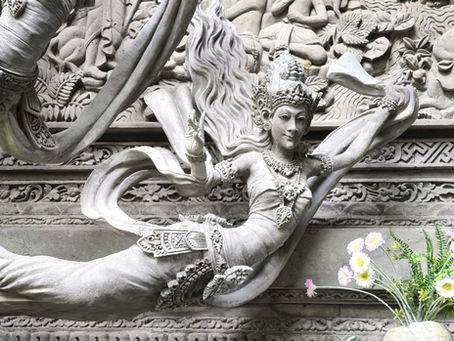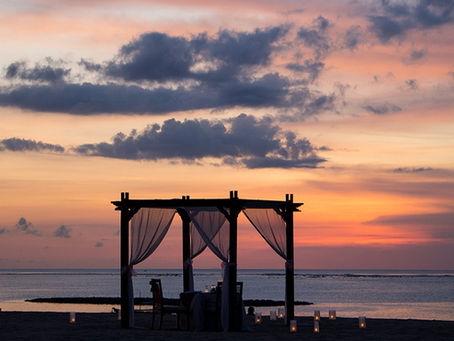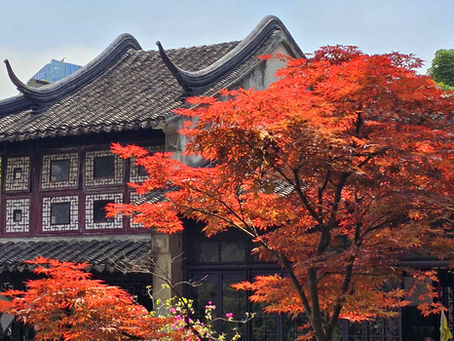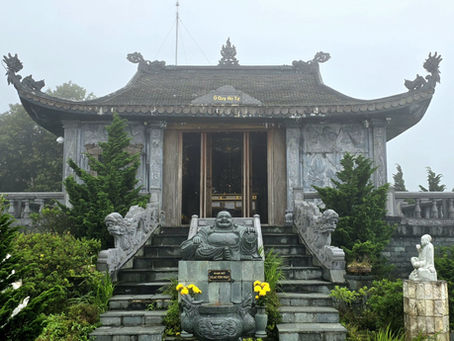top of page

GLOBAL SHANANIGANS

Search


Uluwatu Temple
Overlooking the vast and turbulent Indian Ocean on Bali’s Bukit Peninsula, Uluwatu Temple (or Pura Luhur Uluwatu) perches 70 metres above the waves, a landmark of both awe and solemnity. Archaeological evidence shows its origins date back to the 9th century, based on an ancient split gateway bearing a chronogram marking 886 .AD, confirming its megalithic roots as one of the island’s oldest sacred sites
Shannon


Bhoma - Bali's Protector and Judge
In the architectural language of Balinese temples, Bhoma statues are not merely decorative but play a protective and symbolic role. Bhoma is derived from the ancient Sanskrit word bhūma, meaning “Earth” and is considered a guardian spirit linked to fertility, the forest and subterranean realms. Usually mounted above temple gates or embedded within sacred water features, these fierce, leaf entwined figures serve as guardians of spiritual boundaries,
Shannon


Ganesh - The Remover of Obstacles
In the moss veiled temples of Bali, Ganesha is far more than a familiar Hindu icon, he is a living force who moves between light and shadow. Though his roots lie in Indian Hinduism, Bali’s Ganesha (also known as Batara Gana) has taken on new dimensions, shaped by animist spirits, local rituals and the Balinese understanding of cosmic balance.
Shannon


Taman Dedari - Dine Among the Divine
Born from the legend of Resi Markandeya’s vision of angelic dancers over the Ayung River, Taman Dedari blends myth and appetite in equal measure. Here, guests savour Balinese flavours in a riverside setting guarded by monumental stone Dedari, the celestial maidens of old.
Shannon


Taman Ujung Water Palace
In the heart of Batuan village stands one of Bali’s oldest and most spiritually charged temples: Pura Puseh Desa Batuan. Founded in 1020 AD, it’s recorded in Balinese historical texts that stretch back over a millennium. Its structure is not only physically resilient but symbolically rooted in something far older, believed to have been built atop a megalithic worship site once used for ancestral rites.
Shannon


Gateway to Bali - The Soul of Tuban
Long before it became a quiet suburb near Kuta, Tuban was a vital coastal hub within the ancient Kingdom of Badung, linking Bali to the wider archipelago through maritime trade. Its name, drawn from the sound of retreating waves, reflects a deeper spiritual rhythm, one that still echoes through Balinese belief in the cycles of life, death and rebirth.
Shannon


Hiroshima Castle - Echoes of an Empire
Rising from the flatlands of western Japan, Hiroshima Castle was a powerful nerve centre built by Mōri Terumoto during an age of shifting allegiances and ruthless ambition. With its broad moat and imposing stone walls, the castle was less about isolation and more about control, a symbol of calculated authority in a time of near constant war.
Shannon


Meijiawu Tea Village - Tea of the Emperors
Tucked into the misty hills near Hangzhou’s famous West Lake, Meijiawu is more than just a tea village, it’s a living testament to China’s centuries old relationship with tea. The name "Meijiawu" translates to "The Village of the Mei Family," pointing to a 600-year lineage of hand cultivating tea that began with the Mei clan and continues to thrive today. Over time, this small village grew into a national symbol, with its identity and prosperity deeply intertwined with tea cu
Shannon


The Birth of Apsaras - Daughters of the Ocean of Milk
Apsaras, the celestial nymphs of Hindu and Buddhist mythology, are revered for their unparalleled beauty, graceful movements and mastery of dance and music. Adorned with golden skin, fragrant hair and flowing garments, they appear throughout ancient texts as divine attendants in the heavenly courts of gods like Indra, where they serve as entertainers and symbols of spiritual and aesthetic refinement.
Shannon


Bailong Elevator - In the Shadow of Dragons
Rising like a gleaming spine along the raw sandstone cliffs of Zhangjiajie National Forest Park in China’s Hunan Province, the Bailong Elevator, also known as the "Hundred Dragons Elevator" is both a marvel of modern engineering and a looming monolith that stirs ancient fears. Piercing 326 metres into the sky, it is the tallest outdoor elevator in the world.
Shannon


Hoàn Kiếm Sword Lake and the Turtle Tower
Nestled in Hanoi’s bustling Old Quarter, Hoàn Kiếm Lake offers a serene escape from the city's chaos. This natural freshwater lake, stretching 700 metres across 12 hectares, has been a cultural and historical anchor for centuries, its origins possibly predating Hanoi itself by over a thousand years.
Shannon


Yangshuo County - A Journey Through History and Hills
Tucked deep within Guangxi’s dramatic karst terrain, Yangshuo's landscape is far more than a picturesque backdrop, it is steeped in spiritual and supernatural significance. For centuries, locals have believed the towering limestone peaks to be the resting places of ancient spirits, with many formations given mythological names and stories. One of the most iconic is Moon Hill, named for its crescent shaped cave, which legend says was created by a celestial blade slicing throug
Shannon


The Forgotten History of Đồng Văn
Nestled high in the Dong Van Karst Plateau of Ha Giang Province, Đồng Văn Ancient Town carries within its narrow stone-paved streets a haunting blend of history, war and legend. This remote outpost near the Chinese border has long served as a cultural and military crossroads. The town itself is over a century old, with well-preserved architecture reflecting a fusion of Vietnamese, Chinese and French colonial influences.
Shannon


Carved in Time - Khuổi Ky Stone Village
Known for its striking stone architecture and deeply rooted cultural traditions, Khuổi Ky’s origins trace back over 400 years and was established by the ancient Tay ethnic tribe, after 2,000 years of hardship and migration from the southern regions of China and Cambodia. The Tay people, one of Vietnam’s oldest and most culturally rich ethnic groups, are believed to have journeyed across generations, seeking fertile land and spiritual sanctuary.
Shannon


The Lingering Garden
In a city celebrated for its canals, silk and scholars, Suzhou’s Lingering Garden represents a pinnacle of classical Chinese garden design. Often referred to as one of the “Four Great Classical Gardens of China,” it embodies centuries of artistic refinement and philosophical thought. Built in 1593 during the Ming dynasty by Xu Taishi, a high-ranking official who sought retirement and tranquility, the garden stands as a personal reflection of his scholarly ideals.
Shannon


Ô Quy Hồ Heavens Gate
Often bound in heavy fog, Cổng Trời Ô Quy Hồ or Heavens Gate, is a lesser known temple complex and viewpoint, situated atop the Ô Quy Hồ Pass, one of Vietnam's most majestic mountain passes. Located approximately 18 km's from Sapa town, this pass connects the provinces of Lào Cai and Lai Châu. Perched at an elevation of 2035 metres, it offers visitors panoramic vistas of the Hoàng Liên Sơn mountain range, including glimpses of Fansipan, the highest peak in Indochina.
Shannon


Seven Star Park of the Immortals
Seven Star Park, located on the eastern side of Guilin, Guangxi, derives its name from the formation of seven limestone peaks arranged in the shape of the Big Dipper constellation. This celestial reference is not only a poetic nod to the stars but also deeply symbolic in Chinese cosmology, where the Big Dipper is associated with divine guidance, fate and protection.
Shannon


The Myth and Majesty of Fansipan Mountain
Perched 3143 metres above sea level, Fansipan towers over the stunning Hoàng Liên Son mountain range & national park in northern Vietnam. Often called the “Roof of Indochina,” it is the highest point in the country and the broader Indochinese Peninsula. Yet its significance transcends far beyond altitude. Among the swirling clouds and ancient forest paths, Fansipan is a mountain shrouded in ancestral reverence, layered with wartime memories and wrapped in folklore.
Shannon


Bạch Mã Temple
Bạch Mã Temple, the oldest temple in Hanoi’s Old Quarter, traces its origins back to the year 1010, during the reign of Emperor Lý Thái Tổ. It is one of four sacred temples in the city, constructed to stand as a spiritual guardian for the eastern side of ancient Thang Long (modern-day Hanoi) and was carefully chosen according to the principles of geomancy and the cardinal points.
Shannon


Love Waterfall and the Fairy’s Curse
Located about 13km's down a winding alpine road from Sa Pa town, the majestic Silver Waterfall thunders 200 metres down the cliffs of the Hoàng Liên Son Mountains from the headwaters of the Lo Sui Tong peak. Known to locals as "Thác Bạc" the falls are fed by glacial runoff that originate near the summit of Fansipan, the highest peak and "Roof of Indochina"
Shannon
bottom of page